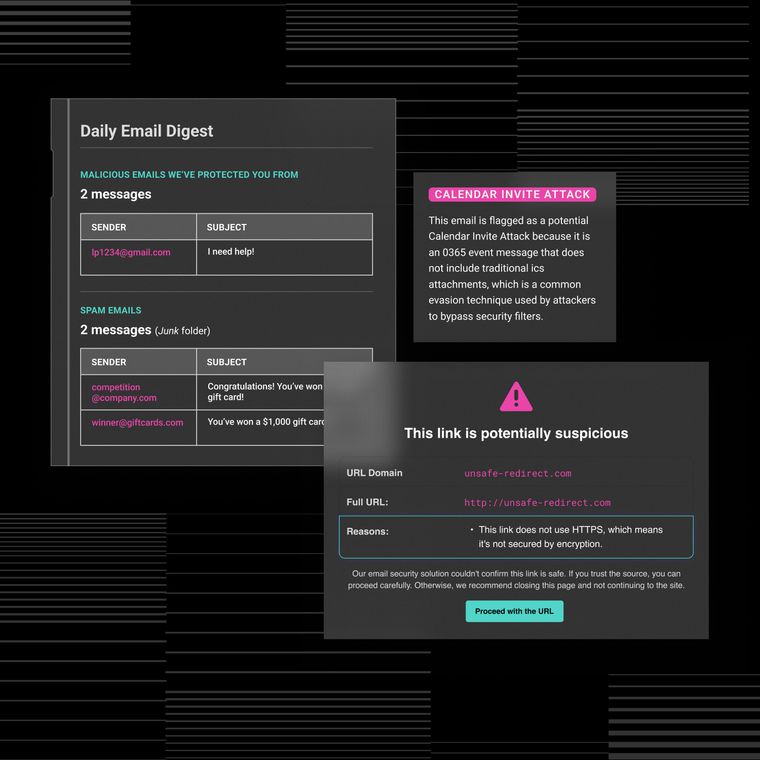The Must-Have Features in Modern Email Security Solutions
Explore essential email security features that help detect, prevent, and respond to today’s advanced attacks.
August 7, 2025
Modern email threats bypass traditional defenses by exploiting trust, behavior, and context instead of malicious payloads. Rule and signature-based tools often fail to detect AI-generated phishing or BEC attacks that mimic internal communication without including known bad indicators.
Attackers now use legitimate platforms, embed links in QR codes, and tailor content with personal details to deceive recipients. These tactics evade native filters in Microsoft 365 and Google Workspace, especially when OAuth permissions or shared settings are abused.
That said, effective email security today requires more than blocklists and static rules. Modern solutions must use behavioral intelligence to learn communication norms, detect subtle anomalies, and respond in real time, ensuring threats are stopped before they cause harm.
What Modern Email Threats Look Like Today
Today’s email threats bypass traditional defenses by combining social engineering, AI-driven personalization, and abuse of legitimate platforms to mimic normal business communication.
AI-Powered Social Engineering at Scale
Attackers use public data from LinkedIn, websites, and databases to craft role-specific, convincing emails. AI tools generate messages that reflect internal tone and context, often sent from compromised accounts or trusted domains, bypassing signature-based detection.
Threats like quishing, malicious links hidden in QR codes, and zero-day links hosted on cloud services evolve faster than blocklists can keep up. As a result, most organizations tend to experience email attacks.
Business Email Compromise Without Payloads
BEC attacks avoid malware entirely, instead relying on psychological tactics and business process manipulation. Attackers monitor email conversations, learn workflows, then send plain-text requests that appear legitimate.
Techniques like reply-to spoofing, look-alike domains, and vendor account hijacking complete the loop, leading to undetected wire fraud. Traditional filters miss these threats because they assess content, not intent.
Modern threats demand behavioral detection that understands communication patterns, not just static indicators. To defend against these evolving tactics, organizations need solutions that go beyond static filters and legacy rules. The following nine features are essential for effective, modern email security.
1. Behavioral AI Analysis
Behavioral AI creates a live model of normal communication patterns, instantly flagging anomalies that traditional signature-based tools completely miss. The platform analyzes 45-60 days of historical email to establish personalized baselines for each user, tracking who they email, when they communicate, and their unique writing patterns.
The system monitors for subtle deviations: executives sending wire transfer requests outside business hours, vendors unexpectedly changing bank details, or logins from unrecognized locations. When content, context, or sender behavior deviates from learned patterns, the system immediately quarantines suspicious emails.
Continuous learning updates the model as roles and communication styles naturally evolve, reducing false positives while stopping nearly half of AI-generated phishing threats that evade static defenses.
2. API-Based Integration Architecture
API-based integration delivers comprehensive email protection without disrupting existing infrastructure or user workflows. This approach connects directly to Microsoft 365 and Google Workspace through native APIs, operating entirely out of band from mail flow. Unlike secure email gateways that require MX record changes and introduce latency, API integration inspects inbound, outbound, and internal messages while maintaining continuous mailbox access.
The solution can remediate threats retroactively, reaching back to remove malicious emails after detection, a capability traditional gateways cannot provide. Deployment requires only OAuth permissions. Once connected, the service attaches to each mailbox and begins protection within minutes. Users maintain their existing workflows while gaining defense-in-depth capabilities that layer seamlessly over native security controls.
This architecture enables deeper visibility into communication patterns and faster threat remediation with zero operational friction, establishing the foundation for modern cloud email security.
3. Three-Pillar Threat Detection
An effective defense against modern email threats relies on three coordinated detection pillars, working together to catch socially engineered attacks that traditional, signature-based filters miss.
Here’s what you need to know:
Identity Verification
This pillar goes deeper than recognizing familiar names. It validates sender identity through domain age analysis, SPF, DKIM, DMARC alignment, and infrastructure reputation checks. These inspections expose spoofed executives or impersonated vendors, especially in plain-text BEC attacks lacking malware or links.
Behavioral Pattern Analysis
This pillar establishes baselines for each user's usual communication style, tracking frequency, tone, timing, and recipient patterns. Anomalies like off-hours emails or sudden urgency trigger immediate review.
Content-Context Evaluation
This pillar uses natural language processing to assess whether message content aligns with expected business processes, spotting well-written but suspicious requests that fall outside organizational norms..
Together, these pillars analyze and correlate signals in real time, reducing false positives and surfacing threats that would otherwise evade detection.
4. Automated Phishing Report Processing
Automated phishing report handling dramatically accelerates response times through fast, accurate verdicts on suspicious emails. Machine learning systems evaluate message content and embedded URLs within minutes, eliminating manual review delays and ensuring prompt removal of malicious emails from all affected inboxes.
This automation reduces the burden on security teams while processing safe, spam, and malicious reports without human intervention. Analysts can focus on high-priority threats, improving overall efficiency. Automated systems easily scale to accommodate large volumes of user reports, making them ideal for organizations with high email traffic.
Consistent performance under load ensures every reported email receives quick review and action, strengthening email security posture while reducing manual workload.
5. Intelligent User Feedback Systems
Intelligent feedback systems transform employee threat reporting into an automated advantage, improving both user awareness and response speed while reducing security team burden.
Faster Response, Smarter Triage
This delivers real-time verdicts when users report suspicious emails. AI-driven analysis using natural language processing and threat intelligence removes malicious emails from all affected inboxes while returning safe messages without analyst input. This eliminates manual triage queues and dramatically reduces mean time to containment.
Real-Time Coaching
This turns each report into a learning opportunity. Generative AI provides clear, personalized explanations of why an email was flagged, highlighting indicators like spoofed domains or social engineering tactics.
Feedback is tailored to the user's communication style and organizational norms, using positive reinforcement to strengthen awareness and build lasting security knowledge.
This approach improves user confidence, promotes consistent reporting, and builds lasting security knowledge, turning everyday actions into effective, ongoing training.
6. Historical Analysis and Baseline Establishment
Historical analysis teaches the system what normal communication looks like before flagging anomalies. The platform ingests 45-60 days of email history via secure API, mapping sender-receiver relationships, typical send times, and writing patterns.
This baseline enables the system to recognize quarterly invoices from finance as routine while flagging midnight wire transfer requests from the same mailbox as suspicious. Continuous learning recalibrates detection thresholds as teams reorganize, new vendors onboard, or communication patterns shift.
The system maintains accuracy without manual rule tuning, adapting to organizational changes in real time. This foundational approach ensures detection stays aligned with actual usage patterns rather than relying on static assumptions that quickly become outdated.
7. Cross-Platform Integration Capabilities
API-based integrations seamlessly embed email threat intelligence into your broader security ecosystem, eliminating manual processes and data silos.
For instance, actionable intelligence links phishing simulation platforms so simulated attacks enter production inboxes and reporting workflows, enabling end-to-end visibility into both user behavior and real threats. Verdicts, indicators, and context feed directly into your SIEM, allowing the SOC to correlate email threats with endpoint, network, and cloud data in real time.
Automated responses through SOAR and ticketing systems remove confirmed threats and update incident records without manual intervention. Standardized metrics export to centralized dashboards, enabling compliance and security teams to track email-related risk alongside other indicators.
These integrations ensure that email intelligence informs and reinforces every layer of your security architecture, driving faster response, better visibility, and stronger protection across the organization.
8. Proactive Threat Hunting and Removal
Proactive threat hunting enables organization-wide scanning of all mailboxes to identify and remove malicious emails before users can engage with them. Given that most organizations face at least one email attack annually, rapid detection and response are essential.
API-based access inspects inbound, outbound, and internal messages in real time, immediately identifying all recipients of suspicious emails. Once confirmed malicious, out-of-band controls automatically remove threats from every affected inbox, reducing exposure windows from hours to seconds.
The system shares threat verdicts across the customer network, preventing the same campaign from succeeding elsewhere. Continuous learning from new attacks recognizes shifts in language, senders, and timing to detect and neutralize emerging threats before they can escalate.
9. Rapid Deployment and Proof of Concept
API-first architecture enables deployment within hours without rerouting mail flow or taxing IT resources.
Quick, Out-of-Band Setup
This connects directly to Microsoft 365 or Google Workspace via OAuth, keeping email traffic in place and avoiding MX record changes. No agents or hardware are needed, making deployment fast and scalable across new domains or business units. Most organizations activate complete protection shortly after procurement.
Seven-Day Read-Only Evaluation
This runs the platform in read-only mode, analyzing 45-60 days of email history to establish behavioral baselines and uncover threats missed by native controls. Security teams receive daily digests of real threats like BEC and payload-free phishing without any risk to mail flow. After validation, a single toggle activates complete remediation.
This rapid, low-risk deployment delivers immediate insights and measurable risk reduction.
Finding All Nine Features in Abnormal Security
Abnormal delivers comprehensive email protection through advanced AI that builds behavioral baselines, understanding how your organization communicates to detect anomalies that legacy systems often miss. This adaptive approach uses machine learning to stay ahead of evolving threats, moving beyond static, signature-based detection.
The platform’s API-first architecture integrates seamlessly with Microsoft 365 and Google Workspace, enhancing protection without disrupting workflows. Deployment is fast and simple, often completed in just a few clicks, avoiding the complexity of traditional secure email gateways.
Abnormal’s AI Security Mailbox also transforms user engagement. It automates phishing report triage, delivers real-time verdicts, and provides educational feedback that strengthens awareness and reporting accuracy.
Within seven days of deployment, the platform begins delivering measurable protection by identifying threats hidden in historical email data, offering rapid value without heavy IT lift.
To see how all nine features work together to protect against modern email threats, request a personalized demo today.
Related Posts
Get the Latest Email Security Insights
Subscribe to our newsletter to receive updates on the latest attacks and new trends in the email threat landscape.


